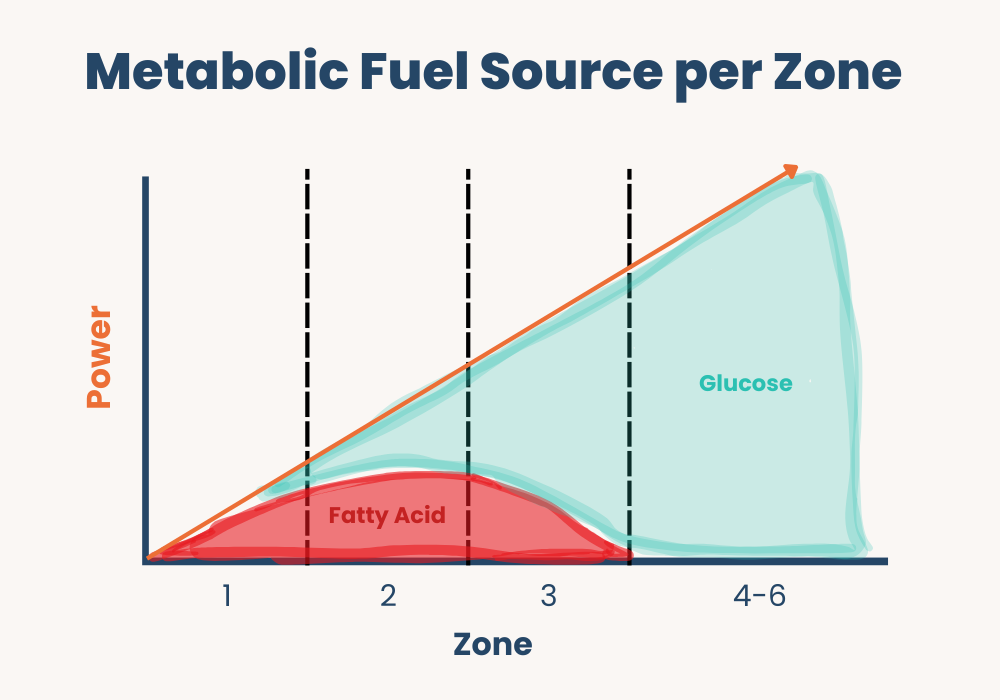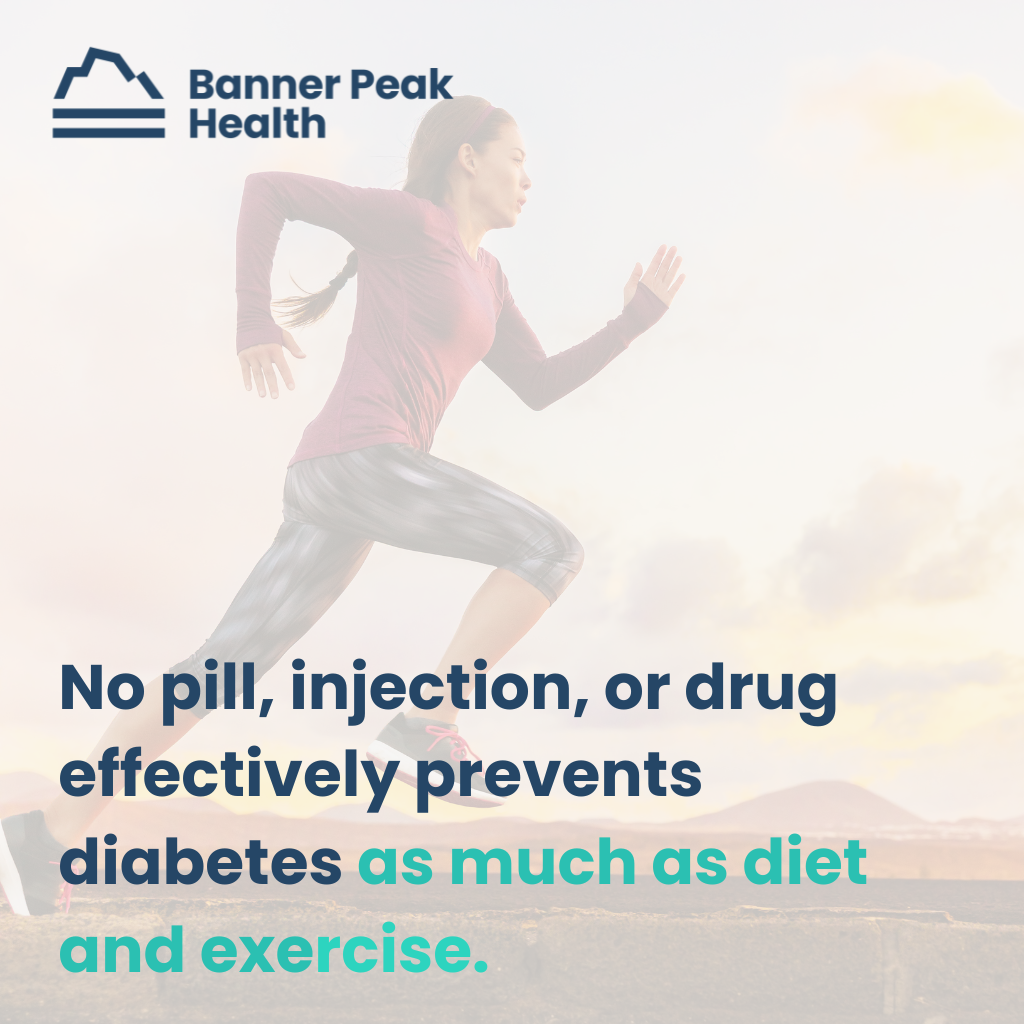
Zone 2 training benefits include:
- Improved mitochondrial function
- Enhanced metabolic flexibility
- Better fatty acid utilization
- Increased endurance performance
- Diabetes prevention and management
While it’s common knowledge that exercise is good for you, the specific advantages of Zone 2 training are less understood. In this comprehensive guide to Zone 2 training benefits, we’ll explore:
- How Zone 2 training transforms your body’s energy systems
- The optimal “dose” of Zone 2 training for maximum benefits
- How to measure and track your Zone 2 training progress
- The scientific evidence behind Zone 2 training benefits
The intensity of cardiovascular exercise can be divided into zones, ranging from no exertion to complete exhaustion. While there are various training zones, Zone 2 stands out for its unique benefits and powerful effects on metabolic health.
Let’s explore why Zone 2 training has become a cornerstone of both elite athletic performance and metabolic health improvement.
Understanding Zone 2 Training Benefits: The Science Behind Cardiovascular Exertion
I’m a huge fan of the Tour de France bike race. Two hundred of the world’s best bike riders pedal over 2,000 miles in three weeks. The competition is so intense that after scores of hours of racing, the top three finishers may be only minutes, or even seconds, apart.
As a recreational bicyclist, I’m fascinated by the bike handling skills and tactics of racing. As a physician, I’m awestruck observing the best endurance athletes on the planet.
Even among the world’s best riders, there are once-in-a-generation athletes. Tadej Pogacar, a Slovenian, won his first Tour de France at 21, the youngest champion since 1904. He won the Tour in 2020, 2021, and 2024.
Watching Tadej take off up a mountain, leaving behind the world’s best riders, is awe-inspiring. In addition to winning the one-in-a-billion genetic lottery, Tadej trains with Dr. Inigo San Millan, a top sports physiologist and coach.
Dr. San Millan raced as an amateur cyclist in the Basque region of Spain before earning a medical degree. He is now a research scientist at the University of Colorado in Boulder.
In addition to sports physiology, Dr. San Millan’s research focuses on metabolic disorders. Much of his work focuses on mitochondrial function, which is prominent in metabolic disorders and sports physiology.
In “Outlive,” Peter Attia cites a 2017 study by Dr. San Millan and George Brooks, which describes the foundational ideas behind Zone 2 training. The authors examined the mitochondrial function of three groups: world-class cyclists, recreational cyclists, and inactive people with pre-diabetes or diabetes.
By comparing how mitochondria function in the world’s best endurance athletes as opposed to diabetics, the study sheds light on metabolic flexibility — what fuel sources the mitochondria can “burn” for energy.
The Metabolic Benefits of Zone 2 Training: Energy Systems Explained
A brief discussion of energy metabolism biochemistry will help us understand Dr. San Millan’s study.
The mitochondria consume either fatty acids or glucose to produce energy. Fatty acids are the preferred fuel source. They have twice the energy density of glucose, 9 kcal/gram, compared to 4 kcal/gram.
Thus, a kilogram of fat (2.2 lbs) provides approximately 9,000 kcal of energy. The average person has many kilograms of fat, which can be mobilized for energy, providing a vast “gas tank.”
In contrast, the body’s storage of glucose in the form of glycogen is limited to around 600 grams, or approximately 2,400 kcal of energy — less than the energy from a quarter of a kilogram of fat. Food sources provide additional glucose, but the digestive system can’t effectively absorb many nutrients during intense exercise.
The liver produces glucose through a process known as gluconeogenesis, but it has a limited capacity and isn’t as energy-efficient as other fuel sources. Gluconeogenesis doesn’t contribute much energy for exercise but prevents low blood sugar during low food intake.
Not only are fatty acids a more plentiful and efficient fuel source for exercise, but their combustion byproducts are also “cleaner” than glucose ones.
Glucose metabolism generates lactic acid, which contains a lactate molecule and a hydrogen ion. Lactic acid has been described as the “bad” waste product from exercise. For example, we used to think that after an intense workout, your thighs burned because of lactic acid buildup.
This is only partially true.
The lactate molecule is beneficial, functioning as an energy source that adjacent muscle cells can consume. The associated hydrogen ion remains a bad factor, lowering the pH in the region and impairing further muscle functioning. The hydrogen ions from glucose metabolism generate a ceiling on muscular energy production’s quantity and duration. In contrast, fatty acids burn cleaner, generating only carbon dioxide and water.
However, the body’s ability to metabolize fatty acids has a finite capacity. With increased energy demand, the systems available to metabolize fatty acids become saturated. Less efficient glucose metabolism is recruited and added to fatty acid consumption to increase energy production further.
Back to the Study…
Inigo San Millan and George Brooks wanted to explore how efficiently each group of people used fatty acids, the preferred fuel source, before using glucose.
Each participant rode an exercise bike with a step-up protocol requiring progressively more power output every 10 minutes. At each step, each participant’s oxygen consumption, carbon dioxide production, power production, and serum lactate levels were recorded.
By analyzing this data, the researchers could calculate the composition of fuel sources used at each power level. For example, because lactic acid is a metabolite of glucose but not fatty acids, it would remain in the low range at lower power levels when fatty acids were the predominant fuel and climb at higher levels as more glucose was used.
Each participant started with more fatty acids burned than glucose. As power increased, additional glucose was consumed, and the percentage of fatty acids burned became smaller.
However, the key finding was the vast differences between the study groups.
The world-class cyclists produced staggering amounts of power while maintaining a stable serum lactate level, meaning they were extremely efficient at burning fatty acids and processing any lactate generated from the glucose they burned. They possessed the best mitochondria on the planet, derived from fortunate genetics and effective training regimens. (More on that topic later.)
In contrast, the deconditioned participants with pre-diabetes or diabetes had the opposite response. These participants had higher lactate levels at rest than the world-class cyclists had while producing large amounts of power. Even before exercising, these participants couldn’t readily access fatty acids and had to rely on glucose, which produced lactic acid.
With minimal exercise, the hydrogen ions from the lactic acid began rapidly building up and limiting exercise duration. This process drastically limited their power — a small fraction of the world-class cyclists. The recreational cyclists had outcomes between these two extremes.
Zone 2 Training Benefits: Evidence From Clinical Research
So, what explains the pre-diabetic and diabetic participants’ results?
Metabolic syndrome — the process of insulin resistance and other hormonal dysfunction that leads to pre-diabetes and potentially diabetes — degrades mitochondrial function through various mechanisms, such as fewer mitochondria and fewer proteins within each mitochondria. These processes limit the ability to metabolize fatty acids and effectively generate power for exercise.
Fortunately, these changes are reversible.
Zone 2
How does the study relate to Zone 2?
Dr. Inigo San Millan defines zones based on the body’s fuel source.
- Zone 1: An intensity that allows mitochondria to use fatty acids but doesn’t exceed their capacity.
- Zone 2: The intensity that maximizes mitochondrial fatty acid utilization for power.
- Zone 3: Occurs when the power requirements exceed the mitochondrial capacity for fatty acid utilization and progressively more glucose utilization is required.
- Zone 4–6: The mitochondria no longer use fatty acids and are defined by other energy sources.

The study has profound implications for athletic training and improving the metabolic health of pre-diabetics and diabetics.
Dr. Inigo San Millan’s training regimen for Tadej Pogacar involved more time in Zone 2 than in any other zone. For Tadej Pogacar to become one of the world’s fastest endurance athletes, he had to spend lots of time biking relatively slowly.
What Is Zone 2?
Zone 2 is the optimal training zone for maximizing endurance and metabolic benefits. It’s characterized by a level of exertion where you can still hold a conversation, typically described as an “all-day” pace. This sweet spot of intensity is where the most powerful Zone 2 training benefits occur.
Zone 2 training intensity improves mitochondrial function by increasing the number and efficiency of mitochondria in muscle cells. In particular, it enhances metabolic flexibility, which maximizes the mitochondria’s consumption of fatty acids for fuel.
As we discussed, fatty acids are the preferred fuel because:
- The body has tremendous fatty acid storage.
- Fatty acid consumption burns cleanly, with no negative feedback loop blocking its metabolism.
- Fatty acid provides a foundation for further levels of metabolism.
Zone 2-enhanced mitochondrial ability allows athletes to go farther more efficiently and reach a higher peak output. Once the power requirement exceeds the mitochondria’s ability to metabolize fatty acids, the body relies on less efficient and more time-limited substrates, such as glucose.
I think of Zone 2 as the booster stage of a multistage rocket ship. The faster and farther it moves the rocket, the less the rocket relies on smaller subsequent stages.
In prior blogs, I’ve discussed the value of measuring VO2 max at peak output, noting that it measures the ability of the entire cardiopulmonary system to function. Zone 2 training at lower intensity provides the foundation that supports other energy systems that allow the body to reach peak output. A massive booster rocket gets you into the sky faster and farther.
Paradoxically, you must go slow to get fast. This is Dr. San Millan’s message and the secret to Tadej Pogacar’s success.
This message has been lost on recreational athletes, who, like me, have limited time for training and assume they should “go hard” whenever possible. Workout apps like Garmin and Strava reinforce this ethos with features to set new personal records, measure peak power outputs, and compete against your friends.
In contrast, effective Zone 2 training requires a relatively slow and deliberate training regimen.
How to Maximize Your Zone 2 Training Benefits: Creating a Personal Program
The first step to creating a Zone 2 training program is identifying your Zone 2 parameters.
This process is more nuanced than reading the workout equipment at the gym, which identifies your “fat-burning” zone as 50–70% of your maximum heart rate. This approximation overlooks many individual characteristics.
Two more accurate techniques for identifying one’s Zone 2 include:
- Replicate the protocol Inigo San Millan and George Brooks used. Measure fingerstick lactate levels or exhaled carbon dioxide and oxygen levels to calculate how intensely you can exercise before you leave the Zone 2 region of fatty acid metabolism. This level of intensity can be expressed in terms of heart rate or power output and can serve as a guide for further workout intensity.
- Use your rate of perceived exertion (RPE), a 10-point scale from absolute rest to complete exhaustion. RPE scores your intensity assessment based largely on your breathing rate, which correlates with exertion. (Carbon dioxide and serum acidity rise with activity level, leading to more rapid breathing.) Zone 2 corresponds to an RPE of 5–6 out of 10 and has a breathing rate that allows you to speak in full sentences.
How much Zone 2 training you need depends on your goals. Professional and elite endurance athletes may spend 80% of their training time in Zone 2, which can be tens of hours a week. The minimum effective dose for us “time-crunched” athletes would be three hours a week, providing noticeable benefits without hurting professional or personal commitments. It may take several months for the maximum benefit to accrue.
Key Zone 2 Training Benefits for Elite and Recreational Athletes
Zone 2 training has become vital to elite athletes’ competitiveness. It can also provide a welcome boost for recreational athletes.
For decades, I’ve biked five to seven hours a week. Given the hilly terrain where I ride, most of that time has been spent above Zone 2 going uphill or below Zone 2 going downhill. I’ll ride in Zone 2 for three hours a week and observe its effects.
In addition to allowing athletes to enhance performance, I suspect the greatest potential benefit of Zone 2 training is improving the metabolic health of those with pre-diabetes and diabetes. We’re amid an unprecedented epidemic of pre-diabetes and diabetes, which correlates with an elevated body mass index. One in three adults in the U.S. is estimated to have prediabetes; another 38 million are fully diabetic!
Mitochondria are the key to understanding insulin resistance and metabolic dysfunction, which leads to pre-diabetes and diabetes. Skeletal muscle cells metabolize up to 90% of the body’s glucose. These cells’ metabolic health, including their mitochondrial function, impacts how the body uses glucose.
Whenever we consume more calories than we burn, we’re in caloric excess. Excess calories are converted to fat and distributed throughout the body. Some locations, such as the thighs and buttocks, have minimal health effects. In contrast, other locations, such as the liver and abdomen, create problems.
Fat deposited within muscle cells impairs mitochondrial function by inhibiting fatty acid use and glucose uptake into the cell, reducing mitochondrial density and efficiency, and creating localized inflammation. When muscle cells can no longer adequately metabolize glucose and fatty acids, glucose levels rise, creating a vicious cycle leading to pre-diabetes and, ultimately, diabetes.
This frightening process has a silver lining: The most effective treatment involves rehabilitating the mitochondria within muscle cells through Zone 2 exercise! No pill, injection, or drug effectively prevents diabetes as much as diet and exercise.
Diet modification is crucial to reverse caloric excess, which deposits fat into cells such as muscle cells and impairs their function. Zone 2 exercise is the most potent tool for improving muscle cell mitochondrial function and can reverse the metabolic effects of pre-diabetes and diabetes.
Final Thoughts on Zone 2 Training Benefits
So, in summary, the key Zone 2 training benefits include:
- Enhanced mitochondrial function and density
- Improved metabolic flexibility
- Efficient fat utilization
- Better endurance capacity
- Diabetes prevention and management
- Enhanced athletic performance
- Sustainable long-term fitness improvements
Three hours a week of Zone 2 training appears to be a good minimum dosage for improving metabolic health and athletic performance. More would be better, but even three hours can be a significant commitment.
Zone 2 training “magically” provides a performance boost to recreational athletes who’ve plateaued within a busy schedule. More importantly, Zone 2 training “magically” corrects the metabolic dysfunction that causes pre-diabetes and diabetes.
At Banner Peak Health, we’re committed to helping you experience these powerful Zone 2 training benefits. Our experts will help determine your optimal Zone 2 parameters, design a personalized training program, and monitor your progress to ensure maximum results. Give us a call and be part of the magic.

Barry Rotman, MD
For over 30 years in medicine, Dr. Rotman has dedicated himself to excellence. With patients’ health as his top priority, he opened his own concierge medical practice in 2007 to practice medicine in a way that lets him truly serve their best interests.




